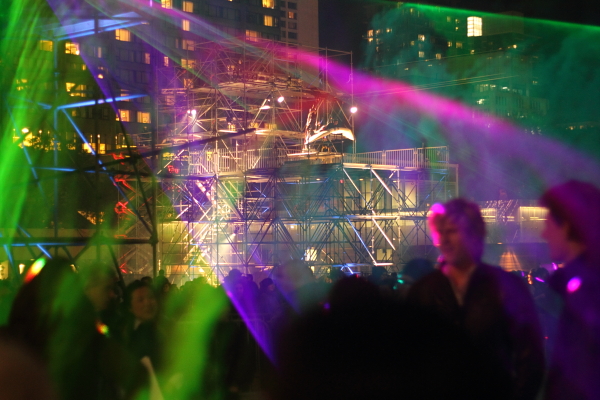October 2011’s Nuit Blanche was chilly indeed, but Murray Whyte’s aptly titled article seems to express a misdirected sense of frustration. Criticizing the fact that Nuit Blanche seems to dissolve into late-night, often dangerous revelling rather than focused engagement with contemporary art works, Whyte, suggests that this ungainliness is foreshadowing the end of Toronto’s all night happening. Ominous as his tone is, Whyte draws attention to important factors such as the declining financial assistance from the city of Toronto leading to a reliance on corporate sponsors, and the disinterested approach taken up by the many individuals whose attendance results from an attraction to the seemingly illicit roaming of the streets. But, while the unruly crowd lends a feeling of the carnivalesque, this level of attendance at an arts-based event is inimitable. Contending with boisterous crowds, especially when comprised of individuals taking advantage of a provided space in which to stay up late and party, is an inherent aspect of popular events. Attending a beloved band’s concert or an NFL football game involves a comparable atmosphere. While this can often compete with one’s enjoyment or appreciation of the event, bidding the whole production adieu doesn’t need to be the response. Nuit Blanche, while sharing the characteristics of other entertainment-based events, is particular in that it is intended to be a showcase of contemporary art; a conceptualized occurrence in which one can experience our urban space in an altered state. Rather than dismissively bid farewell, it seems as though the most productive outlook would be to find a way in which to positively channel the established energy and interest that Nuit Blanche has garnered so far.
Questions which need answering are abundant. How does a spectacular art event such as Nuit Blanche maintain itself as a dynamic exhibition of contemporary art works? How can the event manage a huge influx of people in the downtown core, throughout the wee hours of the night in a safe and conducive way? Comparing Nuit Blanche to other contemporary events proves that this collective and interactive manner of exhibiting and experiencing contemporary art has become firmly established. Contemporary works, many of which are intrinsically connected to the notion of participatory interaction therefore necessitate the involvement of lots of people. Yet how does an artwork, and an artist negotiate the precarious balances that are involved- are works created for such circumstances? Are they designed for the purpose of drawing a crowd, as, Natalie Jeremijenko and Usman Haque’s amusement park-esque attraction “Flight Path” seemed to do with its laser light show and promises of flying with wings (and a zip-line) through the air above Nathan Phillips square. Negotiating the benefits and disadvantages involved in the spectacularization of an impermanent art exhibition is ultimately going to be a constantly fluctuating challenge.
My own Nuit Blanche experience involved staying up the entire night and while it was much more positive than the night Whyte writes about, I was still left with the feeling that the timeframe provided an unrealistic space in which to experience art. For those who are less inclined to lose a full night’s sleep, the stress of negotiating the throngs of people that swarm the downtown core between 6pm and 3am, can diminish the effect of the art. Perhaps more guidance could be provided in the form of maps that not only describe the art works themselves, but define the atmosphere of different areas of the city, in order to direct those attempting to enjoy a night of art, or those who prefer a night of partying. Again this idea of presenting concept-based maps draws attention to the dilemmas provoked by this event: how do we deal with such a highly attended spectacular event, experience contemporary art in a tight time-frame, negotiate the theories and concepts in question, maintain criticality, and avoid the feeling that the experience is being fabricated and then simply consumed.
Miriam Arbus
Note: Murray Whyte published an article about Nuit Blanche 2011 and its future in The Toronto Star on Monday, October 3, 2011.

